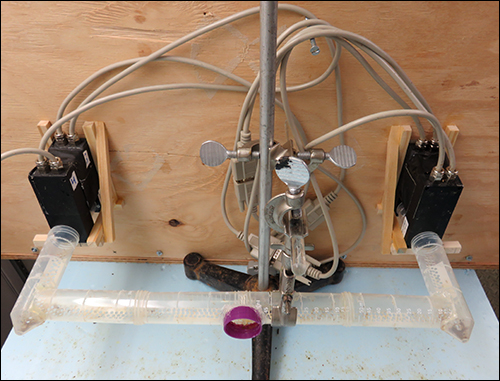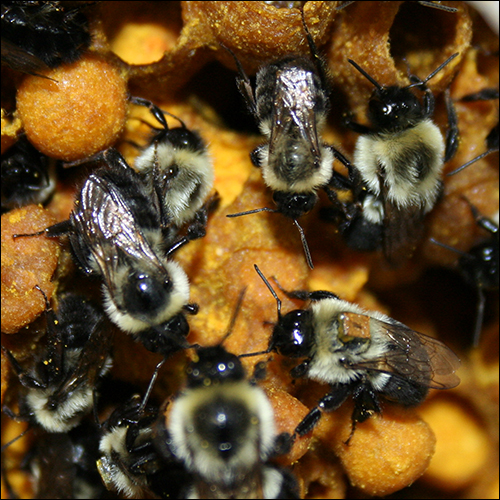Radio frequency identification technology has helped a team of researchers to learn the foraging behavior of bumblebees by tracking their movements into and out of pollen and nectar chambers. A study, led by Avery Russell at the University of Arizona, was published this year, three years after the study took place.
The researchers tracked the movements of a total of 111 individual worker bees, based on high-frequency (HF) 13.56 MHz RFID tags, compliant with the ISO 15693 standard, attached to their backs, and readers at the egress to two chambers. The study found, for the first time, that most worker bumblebees specialize in either pollen or nectar collection, and then switch that specialization throughout their one- to four-week lifespan. The tags and readers were provided by Microsensys.
Prior to the study, scientists did not know how the division of labor was established within a bumblebee hive. Did bees all collect both nectar and pollen, they wondered, or was there a pattern—and, if so, what did that pattern consist of? “There’s been a ton of research on division of labor for insects,” Russell says, though most of that research has been based on visual observations, either manually or with cameras, which can be limiting.
By applying RFID technology to the study, the researchers were able to automatically collect data regarding the activity taking place. Based on the collected RFID data, Russell—the study’s lead author, who was then a doctoral student in entomology and insects, in Professor Daniel Papaj’s Department of Ecology and Evolutionary Biology lab—was able to track those patterns.
A typical bumblebee colony contains up to 75 workers, approximately 40 to 50 of which regularly leave the hive to forage on flowers for nectar and pollen, which they bring back to the hive. To create a controlled environment that could represent a natural one, the researchers installed two chambers by the hive filled with artificial flowersm which presented either pollen or a sucrose solution nectar analogue.
With the system, researchers (in this case, Russell himself) attached the RFID tags to each of 111 bumblebees throughout the six-week period of the study. The tags were adhered to the bees’ backs with superglue. Russell immobilized the bees under a piece of mesh to gain free access to their backs. Then, while their stingers were out of reach, he glued a tag onto each one. While 111 bees were tagged altogether, between 20 and 50 bees were typically foraging and using the tags at any given time. Each bee’s tag had a unique ID number encoded on it.
Two Microsensys MAJA readers were installed at each of the 1.5-inch-diameter tubes that allowed bumblebees to enter and leave the two chambers. At the point at which the readers were attached, the tube narrowed to approximately 2 centimeters (0.8 inch) in width, thereby ensuring a close enough proximity to the tag to capture the bee tag’s ID. Because the bee passed two readers in each tube, the system could identify the direction in which the bee was moving—in or out of the chamber, based on which reader captured the tag ID first.
The university researchers developed their own software to capture and interpret the read data, comprising a total of 82,609 read events. Once the information was collected, the researchers conducted a series of measurements of each bee’s size, wing span and antenna length, as well as other details, and that data was stored along with the tag’s unique ID number, thereby connecting it to the bee’s activity records.

The results indicated that the size of the bee and its antennae did influence foraging rates, and that individual workers tend to specialize in one of the two foraging activities during any given day, then switch to the other chamber after a span of time. The observations also revealed that individual bumblebee workers differ vastly in terms of their foraging activity. In fact, Russell says, there was a 40-fold difference in foraging efforts between some bees. About 17 percent of the bees were collecting approximately 50 percent of the total pollen and nectar. The technology also enabled researchers to study how long the trips took, based on the length of time that a particular bee spent within the chamber, as well as how much time passed between its departure from the chamber and its subsequent return. What’s more, they could determine how long a bee foraged before taking a rest.
The results yielded several surprises, Russell reports. “The specialization and switching of specializations were surprising,” he says, adding, “We didn’t expect such an extreme variation in foraging efforts.”
There were a few challenges with the RFID technology use as well, Russell says. The primary challenge involved the application of tags to the bees, followed by ensuring that the reader captured each passing tag’s ID. The read range was several millimeters, he adds, noting that a longer-range RFID system with more readers might be easier to work with for other projects.
Russell is now a postdoctoral scholar at the University of Pittsburg, but says he hopes, at some point, to launch another bumblebee behavior study using RFID technology. He is specifically interested in navigation patterns among other area of insect behavior.



